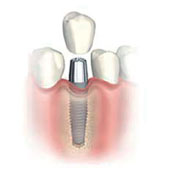Dental implant placement at Haaglanden Clinics
You have opted for one or more implants in your jaw. In this brochure, you will learn more about the treatment and the post-treatment period.
What are dental implants
Implants are artificial roots made of titanium that are placed in the jawbone. For patients who are missing a tooth or teeth, this can be an excellent solution. The implant takes on the function of the tooth root. Implants can be used to support crowns and bridges, as well as to support a denture.
The option of an implant is made in consultation with your dentist. After a physical (dental) examination and x-ray images, the oral surgeon will assess whether your jaw is suitable for an dental implant.
Before the treatment
If you are taking anticoagulant (blood thinning) medications the surgeon will discuss how to manage them.
- It is essential that your lips are in good condition. We recommend regularly moisturizing your lips for a few days before the treatment. This reduces the risk of chapping during the procedure.
- Before the treatment, you will be given a mouthwash to rinse your mouth for one minute.
The treatment
The insertion of the implants takes place on an outpatient basis. During the treatment, your head and upper body will be covered with a sterile cloth. Therefore, we advise you not to wear overly warm clothing. You will receive local anaesthesia. Once the anaesthesia takes effect, the treatment begins. Your gums will be opened, and a hole will be drilled in your jawbone. The implant is then placed in your jaw. Afterward, your gums will be stitched. Placing one or several implants takes approximately thirty to sixty minutes. A post-treatment X-ray will be taken after the implants are inserted. Sometimes, an X-ray is also taken during the procedure.
After the treatment
After the dental implants are inserted, you may leave the clinic. You will receive instructions for aftercare and medication (pain relief).
Risks
Conditions such as diabetes mellitus (diabetes) and periodontitis are risk factors for the treatment not going well. Habits like smoking and teeth grinding also increase the risk of treatment failure. After implant placement, it is also crucial to maintain optimal oral hygiene, and smoking must be avoided completely. Annual check-ups with the dentist and dental hygienist are part of good oral hygiene.
Pain
After the anaesthesia wears off, you may experience some pain. You may be given a prescription for painkillers on the advice of the oral surgeon. We recommend starting with these painkillers before the anesthesia wears off.
Swelling
After the treatment your cheek and/or lip may swell. This is a normal result of the treatment. To limit the swelling we may provide you with a cold pack after the treatment. You can also apply a washcloth filled with ice cubes to your cheek at home. We recommend cooling for fifteen minutes at a time, with intervals of several minutes. The cheek should not freeze. Be careful not to freeze the skin, always wrap the cold pack in a tea towel so the cold does not damage your numbed skin. Your cheek and/or lip may be quite swollen for the first two to three days. The swelling usually disappears after seven to ten days.
Eating and drinking
In principle, you can eat and drink anything after the treatment and after the local anaesthesia has worn off. However, avoid very hard foods (such as baguettes, etc.) in direct contact with the implant. This is because the implant needs to integrate.
Oral hygiene
Good oral hygiene is important for a quick wound healing.
- You can brush your teeth as usual, but be gentler around the wound.
- During the first week, you should rinse your mouth with the prescribed mouthwash twice a day.
- If you have received two implants in your jaw for a click denture, you should not wear your prosthesis for one week. After that, your dentist can adjust the prosthesis so you can wear it again.
Physical exertion
Heavy physical exertion and sports may not be possible. You will know best when a certain posture or activity causes discomfort. The risk of bleeding increases with significant physical exertion.
Fever
After the treatment, you may experience a slight fever. After three to four days, the fever usually decreases.
Contact Haaglanden Clinics when you experience
- A fever above 39 degrees Celsius
- Severe bleeding.
- An increase in swelling and difficulty swallowing 3-5 days after your treatment.
Follow-up appointments
After your treatment, you will receive an appointment for a check-up:
- The first check-up will take place approximately 2 weeks after the treatment
- If everything is fine and you have no complaints, you will return for another check-up after two months. A follow-up X-ray may be taken for evaluation.
Back to the dentist
If you have received a dental implant, it must integrate into your jawbone for 2 to 4 months. Only then can you make an appointment with your dentist to start the crown or dentures.
Finally
In this brochure, we have provided a general overview of the treatment process and the period afterward. Your treatment may differ from what is described here as we tailor the treatment plan to your specific situation.
Do you have any questions after reading the brochure? Feel free to call Haaglanden Clinics. We are available by phone from Monday to Friday, from 08:30 to 12:15 and from 13:00 to 17:00, at telephone number 070 2212121.
In case of emergencies or urgent complaints outside Haaglanden Clinics’ opening hours, please contact the Emergency Department of Haaglanden Medical Center at telephone number 088 9792380.


